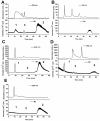A Newly Identified Passive Hyperaccumulator Eucalyptus grandis × E. urophylla under Manganese Stress
- PMID: 26327118
- PMCID: PMC4556624
- DOI: 10.1371/journal.pone.0136606
A Newly Identified Passive Hyperaccumulator Eucalyptus grandis × E. urophylla under Manganese Stress
Abstract
Manganese (Mn) is an essential micronutrient needed for plant growth and development, but can be toxic to plants in excess amounts. However, some plant species have detoxification mechanisms that allow them to accumulate Mn to levels that are normally toxic, a phenomenon known as hyperaccumulation. These species are excellent candidates for developing a cost-effective remediation strategy for Mn-polluted soils. In this study, we identified a new passive Mn-hyperaccumulator Eucalyptus grandis × E. urophylla during a field survey in southern China in July 2010. This hybrid can accumulate as much as 13,549 mg/kg DW Mn in its leaves. Our results from Scanning Electron Microscope (SEM) X-ray microanalysis indicate that Mn is distributed in the entire leaf and stem cross-section, especially in photosynthetic palisade, spongy mesophyll tissue, and stem xylem vessels. Results from size-exclusion chromatography coupled with ICP-MS (Inductively coupled plasma mass spectrometry) lead us to speculate that Mn associates with relatively high molecular weight proteins and low molecular weight organic acids, including tartaric acid, to avoid Mn toxicity. Our results provide experimental evidence that both proteins and organic acids play important roles in Mn detoxification in Eucalyptus grandis × E. urophylla. The key characteristics of Eucalyptus grandis × E. urophylla are an increased Mn translocation facilitated by transpiration through the xylem to the leaves and further distribution throughout the leaf tissues. Moreover, the Mn-speciation profile obtained for the first time in different cellular organelles of Eucalyptus grandis × E. urophylla suggested that different organelles have differential accumulating abilities and unique mechanisms for Mn-detoxification.
Conflict of interest statement
Figures









Similar articles
-
Effect of Low pH and Aluminum Toxicity on the Photosynthetic Characteristics of Different Fast-Growing Eucalyptus Vegetatively Propagated Clones.PLoS One. 2015 Jun 19;10(6):e0130963. doi: 10.1371/journal.pone.0130963. eCollection 2015. PLoS One. 2015. PMID: 26090998 Free PMC article.
-
[Comparison of the water consumption characteristics of Eucalyptus and Corymbia clone seedlings and the local indigenous tree species Bischofia javanica].Ying Yong Sheng Tai Xue Bao. 2014 Jun;25(6):1639-44. Ying Yong Sheng Tai Xue Bao. 2014. PMID: 25223018 Chinese.
-
Phosphorus application reduces aluminum toxicity in two Eucalyptus clones by increasing its accumulation in roots and decreasing its content in leaves.PLoS One. 2018 Jan 11;13(1):e0190900. doi: 10.1371/journal.pone.0190900. eCollection 2018. PLoS One. 2018. PMID: 29324770 Free PMC article.
-
Leaf-age and soil-plant relationships: key factors for reporting trace-elements hyperaccumulation by plants and design applications.Environ Sci Pollut Res Int. 2015 Apr;22(8):5620-32. doi: 10.1007/s11356-014-3445-z. Epub 2014 Aug 21. Environ Sci Pollut Res Int. 2015. PMID: 25138558 Review.
-
Integration of manganese accumulation, subcellular distribution, chemical forms, and physiological responses to understand manganese tolerance in Macleaya cordata.Environ Sci Pollut Res Int. 2022 Jun;29(26):39017-39026. doi: 10.1007/s11356-022-19562-8. Epub 2022 Mar 19. Environ Sci Pollut Res Int. 2022. PMID: 35306649 Review.
Cited by
-
Functional trait divergence associated with heteromorphic leaves in a climbing fig.Front Plant Sci. 2023 Sep 19;14:1261240. doi: 10.3389/fpls.2023.1261240. eCollection 2023. Front Plant Sci. 2023. PMID: 37794929 Free PMC article.
-
Sex-specific competition differently regulates the response of the rhizosphere fungal community of Hippophae rhamnoides-A dioecious plant, under Mn stress.Front Microbiol. 2023 Jan 19;14:1102904. doi: 10.3389/fmicb.2023.1102904. eCollection 2023. Front Microbiol. 2023. PMID: 36744096 Free PMC article.
-
Phytoremediation of Mn-contaminated paddy soil by two hyperaccumulators (Phytolacca americana and Polygonum hydropiper) aided with citric acid.Environ Sci Pollut Res Int. 2018 Sep;25(26):25933-25941. doi: 10.1007/s11356-018-2647-1. Epub 2018 Jul 1. Environ Sci Pollut Res Int. 2018. PMID: 29961905
-
Potential of Eucalyptus camaldulensis for phytostabilization and biomonitoring of trace-element contaminated soils.PLoS One. 2017 Jun 30;12(6):e0180240. doi: 10.1371/journal.pone.0180240. eCollection 2017. PLoS One. 2017. PMID: 28666017 Free PMC article.
-
Trace Elements in Leaf Extracts of Eucalyptus grandis Traditionally Used to Treat Common Cold and Flu.J Health Pollut. 2019 Dec 6;9(24):191214. doi: 10.5696/2156-9614-9.24.191214. eCollection 2019 Dec. J Health Pollut. 2019. PMID: 31893175 Free PMC article.
References
-
- Horst M. Mineral nutrition of higher plants Academic Press; 2011.
-
- Karki P LE, Aschner M. Manganese neurotoxicity: a focus on glutamate transporters. Annals of occupational and environmental medicine. 2013;25(4). Available: http://www.aoemj.com/content/25/1/4. - PMC - PubMed
Publication types
MeSH terms
Substances
LinkOut - more resources
Full Text Sources
Other Literature Sources

